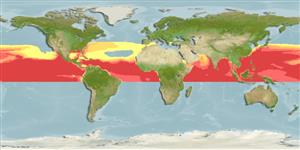Environment: milieu / climate zone / depth range / distribution range
экология
морской; мигрирует в океане (Ref. 51243); пределы глубины 0 - ? m. Tropical; 42°N - 36°S, 180°W - 180°E (Ref. 93339)
Circumglobal: all oceans preferably open ocean waters.
Atlantic: northward from 37°N in the western part of the ocean to 25° N in the eastern part and southward from 30° S in the western part to 8° S in the eastern part; somewhat broader in the Eastern Atlantic. It is quite rare in the Caribbean (except for the eastern part) and in the Gulf of Mexico.
Indian Ocean: Arabian Sea and Bay of Bengal in the north to the southern end of Africa and the western coast of Australia in the south; not found in the Red Sea, Aden, Oman and the Persian Gulfs, as well as in the easternmost part of the Indian Ocean in the waters between the southern Indonesian islands and the northern coast of Australia. Juveniles are distributed throughout the range of the species except in the most southwestern areas from the Mozambique Channel to the False Bay and in the waters off the west coast of Australia; juveniles were found in all seasons.
Pacific Ocean: northward from the northwestern tip of the Honshu Island in the west to 20° N in the east, and southward from the east coast of Australia to the waters of Ecuador and
Peru. Absent in the East China, Yellow and Japan Seas, quite rare in the South China Sea, none in the inner Indonesian seas.
Size / Вес / Возраст
Maturity: Lm ? range ? - ? cm
Max length : 25.1 cm SL самец/пол неопределен; (Ref. 93339)
колючие лучи спинного плавника (общее число): 0; членистые (мягкие) лучи спинного плавника (общее число): 10-12; колючие лучи анального плавника 0; членистые (мягкие) лучи анального плавника: 11 - 13. Body dark, iridescent blue above, silvery white below; dorsal and caudal fins greyish, other fins hyaline (Ref. 2797). Juveniles elongate, paired fins mottled (Ref. 2797).
Found in oceanic surface waters (Ref. 9839). Caught in surface waters over the depths 80-10,400 meters, usually 2000 to 6000 m (mean 4423 m) (Ref. 93339). Spawns throughout the year in warm waters (Ref. 6523).
Life cycle and mating behavior
половая зрелость | размножение | нерест | икра | Fecundity | личинки
Shakhovskoy, I.B. and N.V. Parin, 2013. A review of flying fishes of the subgenus Hirundichthys (genus Hirundichthys, Exocoetidae). 1. Oceanic species: H. speculiger, H. indicus sp. nova. J. Ichthyol. 53(2):117-145. (Ref. 93339)
Статус Красного Списка МСОП (Ref. 130435)
Угроза для людей
Harmless
Использование человеком
рыболовство: не имеет хозяйственного значения
дополнительная информация
народные названиясинонимыобмен веществхищникиэкотоксикологияразмножениеполовая зрелостьнерестSpawning aggregationFecundityикраРазвитие икры
ссылкиаквакультура (рыбоводство)особенности рыбоводствастепень растяжениягенетикаElectrophoresesнаследуемостьболезниобработкаNutrientsMass conversion
соавторыизображенияStamps, Coins Misc.звукиCiguateraскоростьтип плаванияжаберная областьOtolithsмозгзрение
инструменты
Специальные отчеты
Скачать в формате XML
ресурсы в Интернет
Estimates based on models
Preferred temperature (Ref.
123201): 1.2 - 2.9, mean 1.5 °C (based on 26666 cells).
Phylogenetic diversity index (Ref.
82804): PD
50 = 0.5002 [Uniqueness, from 0.5 = low to 2.0 = high].
Bayesian length-weight: a=0.00646 (0.00292 - 0.01429), b=3.04 (2.84 - 3.24), in cm total length, based on LWR estimates for this (Sub)family-body shape (Ref.
93245).
Trophic level (Ref.
69278): 3.0 ±0.08 se; based on food items.
устойчивость к внешним воздействиям (Ref.
120179): высокий, минимальное время удвоения популяции до 15 месяцев (Preliminary K or Fecundity.).
Fishing Vulnerability (Ref.
59153): Low vulnerability (21 of 100).
